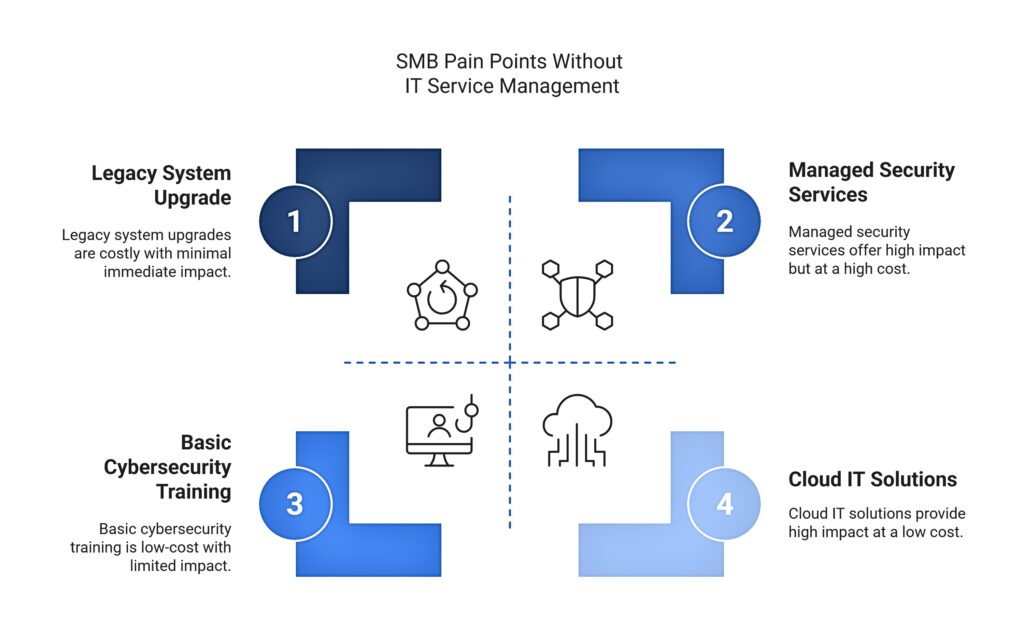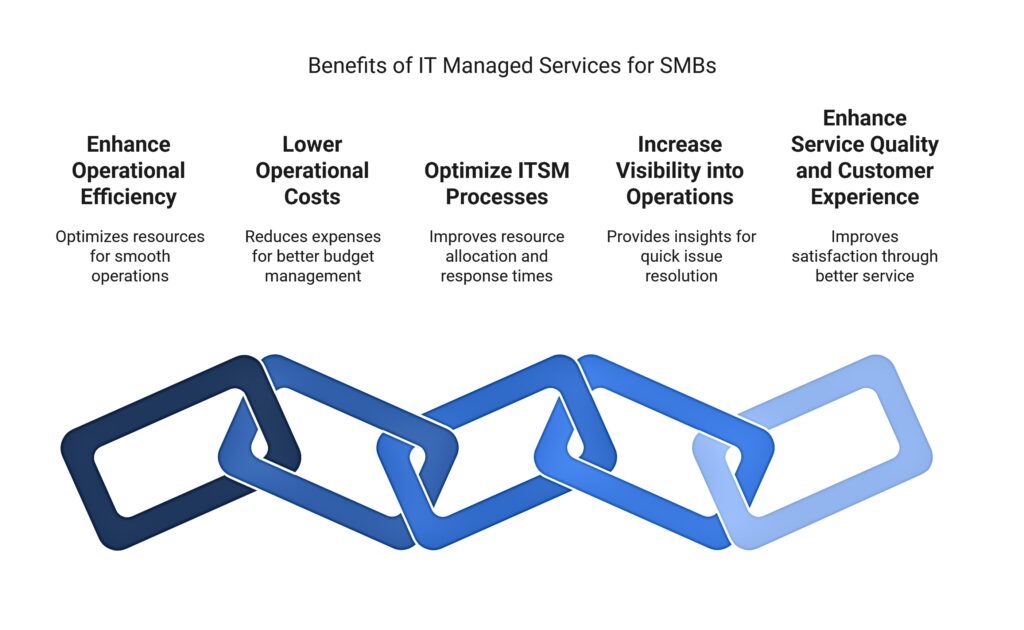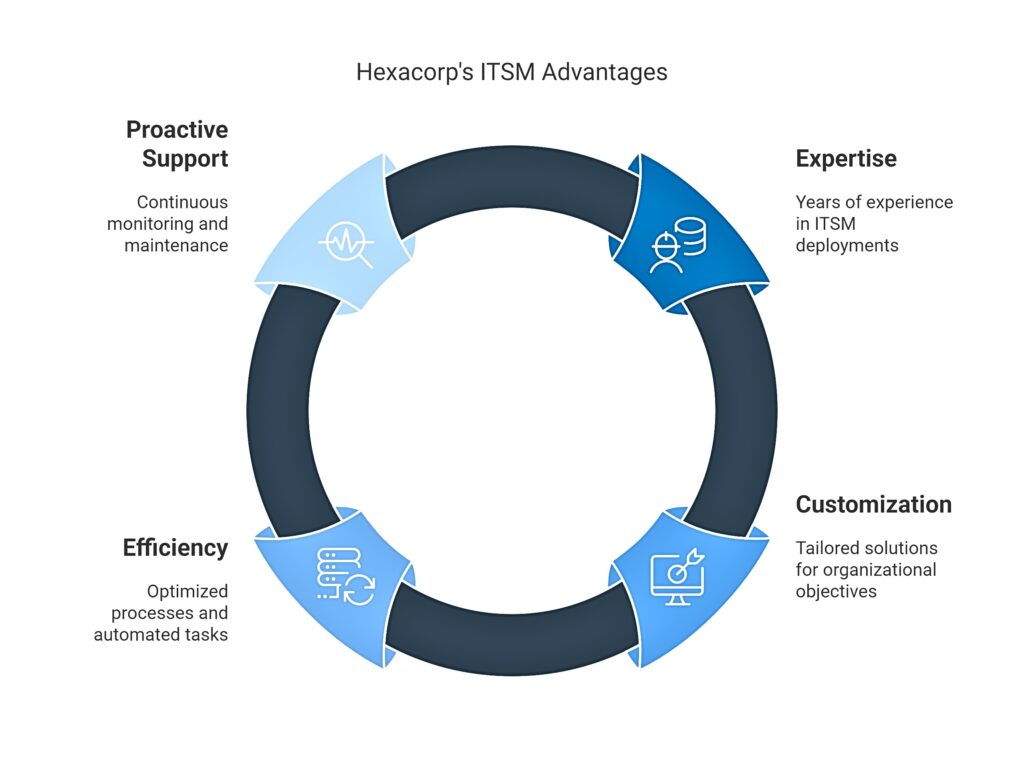- April 29, 2025
Managing IT operations can be increasingly challenging for SMBs, do you agree?
Right from fragmented processes to lack of automation and escalating costs, small and medium businesses often confront a myriad of roadblocks that can hold back productivity and growth,
Disparate systems, poor incident resolution and juggling multiple tools adds to the complexity, making it hard for businesses to get visibility, streamline workflows and deliver consistent IT services.
IT Service Management answers all these challenges in a much more efficient way. With its structured and scalable approach ITSM helps SMBs to optimize IT processes, improve service quality and unlock long term efficiencies.
This blog covers how ITSM tools can manage addresses specific intrinsic challenges and pain points that SMBs confront, and transformative benefits of adopting IT service management which includes cost savings, enhanced user satisfaction, and improved efficiency.
Stay tuned as we uncover how IT service management becomes the cornerstone of streamlined, and successful IT operations.
Pain Points SMBs Confront without IT Service Management

In this digital age, small & medium businesses need to proactively address the below pain points and implement sustainable solutions that can significantly impact productivity & growth.
- Security: Small & medium businesses are primary targets of cyberattacks as they contain very minimal or limited security infrastructure. Such vulnerability paves the way for data breaches, ransomware attacks, loss of money, and damaged reputation.
Solution: Use Multi-Factor Authentication, which is a two-step login, do regular safety checks, and teach workers about the best ways to stay safe online. Think about investing in managed safety services.
- IT Expertise: Finding and keeping skilled IT workers can cost a lot and be tough for small and medium-sized businesses. This can leave them open to outages and slow response times.
Solution: Consider outsourcing IT managed services to manage your IT needs. Look into cloud options that do not need much tech knowledge. Train your current staff to be better at IT.
- Outdated Technology/Legacy Systems: Using outdated hardware and software can hurt productivity, security, and growth. It can also cause problems with compatibility and cost more to maintain.
Solution: Create a plan to update your tech and set aside budget accordingly.
- Constrained Budget: IT service expenditure can all of a sudden impact on the finances of SMBs. This often leads to skimping on security, software, and hardware, which ends up causing more issues down the line.
Solution: Keep an eye out for budget-friendly IT options like open-source software and cloud services. Talk to IT managed service providers about better deals and focus your IT spending on what your business needs.
Points to remember: Tackling IT service management problems head-on is key for SMBs to succeed. By following the steps listed above, you’ll ensure your company has the tech foundation it needs to grow in today’s digital world.
What is ITSM & How is it Significant for SMBs?
IT Service Management covers all the processes that IT managed service providers help right from client’s plan, design, and deliver IT solutions. It aims to create a process-based framework that blends IT services into organizations’ everyday tasks.
ITSM also means running IT as a service management platform, building a lasting partnership between the IT service provider and the client to make sure services are delivered well.
ITSM allows service providers to deliver effective IT solutions using IT management principles, frameworks, and automated services operations. It manages many different processes and components to ensure IT Service Management is aligned with business requirements. Key elements include:
Asset Management:
This involves the effective management and lifecycle of organizational assets, from their initial deployment to eventual decommissioning. By integrating with change and configuration management, this process enhances the efficient use of IT resources.
Change Management:
This process oversees changes within the IT infrastructure by monitoring and controlling updates to reduce disruptions. It ensures that software and infrastructure modifications are carried out smoothly, minimizing their impact on business operations.
Service Management:
This area deals with service requests, including application access, hardware upgrades, software updates, and similar tasks. It guarantees that user needs are addressed promptly and efficiently.
Incident Management:
This focuses on responding to and resolving unexpected service interruptions. Utilizing tools like incident reports, this process ensures that sporadic issues are quickly managed to restore normal operations.
Information Management:
This maintains and organizes IT-related information throughout the organization, making it easily accessible for stakeholders to find, use, and manage IT service data effectively.
Configuration Management:
This tracks Configuration Items (CIs) within an IT system, highlighting the relationships between hardware and software assets. It ensures a clear understanding of how these components influence business outcomes.
Problem Management:
This identifies and tackles the root causes of recurring incidents and issues. Unlike incident management, which deals with immediate disruptions, problem management aims to prevent future occurrences by addressing underlying problems.
How is it Significant for SMBs?
As IT continues to transform various industries, the importance of IT Service Management (ITSM) becomes more apparent. ITSM is crucial for helping organizations meet their business goals by effectively integrating IT services with business processes to drive outcomes and address operational needs.
Here are some key reasons why ITSM is essential for businesses:
- Accurate Metrics: ITSM allows organizations to measure and analyze business metrics accurately, offering valuable insights for better decision-making.
- Enhanced Service Strategy: IT service management services enable IT professionals to improve service strategies and raise service levels throughout the organization.
- Swift Incident Response: ITSM prepares teams to react quickly and effectively to incidents, minimizing disruptions to operations.
- Streamlined Customer Service: It aligns customer service processes with organizational objectives, boosting efficiency and customer satisfaction.
- Collaborative Project Management: ITSM promotes collaboration between IT professionals and development teams through a structured project management framework.
Key Benefits of Implementing IT Managed Services for SMBs

- Enhance Operational Efficiency: One of the key advantages of ITSM is its capacity to improve operational efficiency by optimizing organizational resources. By effectively managing the lifecycle of IT assets and directing them to the areas where they are most needed, ITSM helps organizations operate smoothly. It also allows companies to implement cost-effective strategies for acquiring and retiring IT assets, fostering continuous service improvement while enhancing efficiency and business agility.
- Lower Operational Costs: ITSM is essential in reducing operational costs, which can be a major expense for many organizations. By cutting these costs, companies can manage their budgets more effectively and allocate funds to other vital areas of the business. With a successful ITSM implementation, organizations can boost the output of their IT solutions while decreasing overhead, ultimately enhancing daily business operations, and freeing up capital for growth and expansion.
- Optimize ITSM Processes: Optimizing ITSM processes enables businesses to save time by concentrating efforts more effectively, minimizing resource duplication, and improving overall response times. This allows organizations to swiftly reallocate resources as necessary, ensuring that all business areas receive the attention they require. Customizing ITSM processes to align with the specific needs of different business sectors helps enhance performance and support operational objectives.
- Increase Visibility into Operations: ITSM offers valuable insights into operations by facilitating accurate measurement and tracking. This empowers IT teams to quickly identify and resolve service outages, respond promptly to service requests, and understand how IT solutions align with business goals. It also enables faster troubleshooting by allowing teams to anticipate and identify issues before they escalate.
- Enhance Service Quality and Customer Experience: A well-designed ITSM framework can greatly enhance service quality and improve customer experience. With ITSM, businesses get to streamline business processes and improve customer satisfaction through management software that enables seamless communication, and efficient service delivery.
Real-World Impact: How ITSM Transforms SMBs
In your pursuit of better service management and customer experiences, ITSM stands out as a crucial tool. By implementing ITSM principles and tools, you can simplify service management processes, enhancing both efficiency and responsiveness.
1.Enhancing Service Management with ITSM
Service Requests and Service Desk: ITSM automates and simplifies service requests through a robust service desk. With ITSM, you can:
- Offer a self-service portal for easy submission and tracking of requests.
- Automate workflows to quickly direct requests to the appropriate teams.
- Maintain a knowledge base to resolve issues more swiftly.
Knowledge Management: ITSM facilitates effective knowledge management by centralizing information and solutions, enabling:
- Rapid access to answers for common issues.
- Shorter resolution times.
- Consistency and accuracy in service delivery.
Automation and Workflow: ITSM automate processes to boost efficiency, allowing you to:
- Quickly route requests to the right teams.
- Ensure resolutions are timely. Reduce manual intervention and errors.
Incident and Asset Management: ITSM is particularly strong in incident and asset management, assisting you to:
- Quickly track and resolve incidents.
- Proactively tackle potential issues.
- Monitor and optimize asset usage for cost savings and improved efficiency.
- With ITSM, you can enhance operations, improve service delivery, and increase customer satisfaction.
2. Enhancing Efficiency with ITSM Tools
Are you overwhelmed by a never-ending stream of tickets? ITSM tools can simplify your ticket management and automate routine tasks, enabling you to concentrate on strategic objectives while enhancing service efficiency.
Benefits of ITSM Tools
- Ticket Management: Streamline ticket creation and routing to cut down response times and boost satisfaction.
- Knowledge Base: Provide a self-service knowledge base available 24/7 to minimize support requests.
- Problem Management: Tackle the root causes of recurring issues to improve service quality.
- Self-Service: Give stakeholders self-service options to lessen their reliance on support. ITSM tools enhance stakeholder engagement by offering easy access to information and automated updates on request statuses. Automate tasks, streamline processes, and increase efficiency with ITSM.
Why Choose Hexacorp for ITSM Tool Deployment & Management?
Hexacorp takes a holistic approach to deploying IT service management tools, ensuring they integrate smoothly with your current systems. Our skilled team collaborates with you to grasp your specific requirements and deliver customized solutions that boost operational efficiency and service delivery.

Here’s why partnering with Hexacorp is a smart choice:
- Expertise: With years of experience in ITSM deployments, we ensure your tool is configured and managed to align with your business goals.
- Customization: Our solutions are tailored to fit your organization’s objectives, enhancing ticket management, problem-solving, and overall IT service quality.
- Efficiency: We optimize processes, automate routine tasks, and improve workflows, resulting in better resource management and quicker issue resolution.
- Proactive Support: Our proactive approach guarantees that your ITSM tool runs at its best, with continuous monitoring, maintenance, and optimization.
With Hexacorp, you can unlock the full potential of ITSM tools to enhance your IT service management and propel your business forward.
Conclusion
Adopting IT service management services can make SMBs stay streamlined in their routine tasks and engage with customer interactions much more effectively. With ITSM tools, companies can streamline and enhance essential processes, leading to better efficiency and service quality. The IT service desk is vital in this framework, serving as the main contact point for handling incidents and service requests. Although an IT service desk provides a wider array of services compared to a traditional help desk, both are crucial for maintaining smooth and effective IT operations. Adopting ITSM allows organizations to boost their overall IT performance, cut costs, and increase user satisfaction.
Happy Learning!!
FAQs
What is IT Service Management (ITSM)?
IT Service Management refers to a collection of practices and processes designed to ensure that IT services are delivered effectively and meet the needs of the business. It emphasizes the design, delivery, and management of these services.
What is an ITSM tool?
An ITSM tool is a software application that assists organizations in managing and automating various IT service management processes, including incident, change, and request management. This tool enhances efficiency and improves the overall delivery of services.
How does an IT service desk fit into ITSM?
The IT service desk plays a crucial role in ITSM by serving as the main point of contact for handling incidents, service requests, and facilitating communication between IT teams and users. It is essential for maintaining smooth IT operations.
What is the difference between an IT service desk and a help desk?
The main distinction between an IT service desk and a help desk lies in their scope, an IT service desk encompasses a wider range of IT service management functions, whereas a help desk is primarily focused on resolving technical issues and addressing user inquiries.




